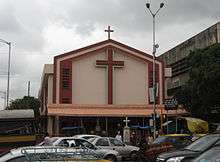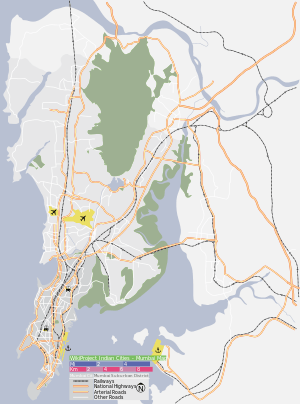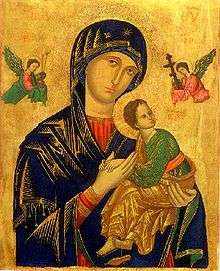St. Michael's Church, Mumbai
St. Michael's Church is one of the oldest Catholic churches in Mumbai. The church is situated in Mahim, located at the intersection of L.J. Road and Mahim Causeway. The church was originally built by the Portuguese in 1534. Initially known as San Miguel, it is the oldest Portuguese Franciscan church in Mumbai.[2] It was rebuilt a number of times; the present structure dating to 1973. The church also served as a refuge to the popular icon of the Virgin Mary from Our Lady of the Mount chapel, Bandra from 1739 to 1761.
| St. Michael's Church | |
| Mahim Church | |
सेंट मायकल चर्च | |
 Picture of the St. Michael's Church in Mumbai | |
 St. Michael's Church, Mumbai | |
| 19.0425°N 72.8405°E | |
| Location | Mahim , Mumbai |
|---|---|
| Country | India |
| Denomination | Roman Catholic |
| Tradition | Novena |
| Website | www |
| History | |
| Status | Parish Church |
| Founded | 1534 |
| Architecture | |
| Functional status | Active |
| Administration | |
| Deanery | North Mumbai Deanery |
| Archdiocese | Archdiocese of Bombay |
| Clergy | |
| Archbishop | Oswald Gracias |
| Priest in charge | Fr. Lancy Pinto |
| Priest(s) | Fr. Ashwin Castellino |
| Assistant priest(s) | Fr. Simon Borges, Fr. Bento Cardozo, Fr. Yeshuraj[1] |
Due to its location, it is also informally known as Mahim Church.[3] The church is famous for its Novenas on Wednesdays, which is visited by thousands.[4]
History
The original St. Michael's Church is believed to have been built in 1534 by António do Porto, a church builder of the Franciscan Order.[4] When the Marathas conquered Salsette in 1739, Our Lady of the Mount chapel in Bandra was destroyed by the Portuguese at the instance of the British so that its location remained secret to the Marathas. In this time, St. Michael's Church was the refuge place for the image of the Blessed Virgin from the chapel. The image remained in St. Michael's till 1761, when it was moved to its present structure in Bandra.[4]
In 1853, St. Michael's Church witnessed a struggle between Bishop Anastasius Hartmann and the padroado order. St. Michael's was in control of the vicars apostolic for nearly 60 years. In 1853, a discontented group decided that the control be handed over to the padroado party. To prevent this, Hartmann as the vicars's leader, went to the church and declared that "he would rather die a martyr than surrender the church to the schismatics". Hartmann and his followers stayed in the church with enough food and water for 15 days. Hartmann's opponents had laid "siege" to the church in this period, blocking all entrances. On the 15th day, civil authorities intervened and insisted that the church be reopened. Following this, Hartmann lost control of the church, passing it to padroado order.[5]
In his 1917 book, Sheppard remarks that St. Michael's was situated on the Portuguese Church Street and is one of the four "only known Portuguese buildings; and of these no distinguishing original feature survives, as they were much rebuilt".[6] The present structure of St. Michaels was rebuilt in 1973.[7]
Novena

St. Michael's sees a large number of people on Wednesdays every week, when novena prayers to Our Lady of Perpetual Succour are held throughout the day. These services are attended by people of all faiths.[8] Devotees believe that visiting the Church on nine consecutive Wednesdays (Novena) will grant their wishes.[3] Some of them offer wax figures of what they desire, for example, a wax house. According to Father Hugh Fonseca, around 40-50,000 devotees visit the church every week.[9]
The weekly Novena services were started in 1948, when a Father Edward Placidus Fernandes from Bombay noticed a similar ritual celebrating Our Lady of Perpetual Succour at Belfast, Northern Ireland, during his visit to Europe. Fr. Fernandes brought with him a picture touched to the original icon at Rome. On 8 September 1948 – the Birthday of Mary, concurrent with a Wednesday that year, Fr. Fernandes as the vicar held the first Novena services. Initially, only two services were held every Wednesday, but today from 8:30 am to 10:30 pm, the thirteen services are held in various languages: English, Konkani, Marathi, Tamil and Hindi.[10] In 2014, A painting of the Our Lady of Perpetual Succor was gifted to St. Michaels by the Vatican. The painting is an authentic hand painted version of the original icon in Rome.[11]
Reported "Bleeding" Christ picture
| Part of a series on the |
| History of Mumbai |
|---|
| Pre-historic period |
| Kolis East Indians |
| Ancient period |
|
| Islamic period |
|
| Portuguese period |
|
| British period |
|
| Independent India |
|
On 27 June 2008, thousands of devotees visited St. Michael's to see the picture of Jesus called "the Divine Mercy". The picture showed some red spots which were believed to be blood near the heart of Jesus. The spots were noticed on the day at 8.30 pm on the occasion of the feast of Our Lady of Perpetual Help and were termed as a "miracle" by devotees. Not only Christians, but also Hindus and Muslims from Maharashtra and the neighbouring states of Goa, Karnataka and Gujarat, visited the Church to catch a glimpse of the picture. The queue to St. Michael's extended more than a kilometre.[12][13][14]
Parish Priest Father Raphael and Father Doneth D'Souza from the St. Michael's church as well as Archbishop cardinal Oswald Gracias declined the miracle claim. Fr. D'Souza explained "It's not a blood stain and it's also not a miracle. Every image of Divine Mercy has a red halo around the heart and in this case, the red colour has run because of the moisture in the air. It will look like a blood stain, but it's not."[12][13][14]
The image was removed and sent to a scientific analysis on the orders of Oswald Gracias. The result of that study was released in the September archdiocesan weekly and it said that the tests "established that there are no traces of blood in the red rays emanating from the Heart of Jesus in this image of Divine Mercy". Monsoon humidity and changes in the air quality were the suspected causes, Oswald Gracias did not explain the exact reasons.[15]
See also
- Saint Michael: Roman Catholic traditions and views
References
- "Home – St. Michael's Church". www.stmichaelsmahim.com. Retrieved 10 December 2017.
- Edwardes, Stephen Meredyth (1902), The Rise of Bombay: A Retrospect, Times of India Press, p. 75
- "Mary in the Secular Press". Mary Page News. University of Dayton. 26 January 2001.
- Parvate, T. V. "Greater Bombay District". Maharashtra State Gazetteer. Retrieved 24 December 2008.
- Neill, Stephen (2002). A History of Christianity in India. Cambridge University Press. pp. 290–1. ISBN 0-521-89332-1.
- Sheppard, Samuel T. (1917). Bombay Place-Names and Street-Names: An Excursion into the by-ways of the history of Bombay City. Bombay: The Times Press.
- "St Michael's Church Mumbai". Hotels in Mumbai. Retrieved 24 December 2008.
- "The Scent of Yesterday: A nostalgic look at Mahim of the' 50s and '60s". Mid Day. 15 May 2014. Retrieved 22 March 2016.
- Guha, Tresha (17 January 2008). "Say a little prayer". DownTown Plus. The Times of India. Retrieved 24 December 2007.
- "The Perpetual Novena of Our Lady of Perpetual Help". ChurchesinIndia.com. Retrieved 24 December 2008.
- "Vatican gifts painting to Mahim church". The Times of India. 31 December 2014. Retrieved 22 March 2016.
- "Devotees flock to Mahim church to see 'bleeding' Jesus". CNN-IBN. 28 June 2008. Retrieved 24 December 2008.
- Singh, Varun (30 June 2008). "Bleeding Jesus is not a miracle: church". MiD DAY. Retrieved 24 December 2008.
- Henderson, Barney (29 June 2008). "Jesus 'bleeds' in Mumbai church". Hindustan Times. Retrieved 24 December 2008.
- No blood in bleeding Jesus’ picture: Study September 3, 2008 Indian Catholic
External links
| Wikimedia Commons has media related to St. Michael's Church, Mumbai. |